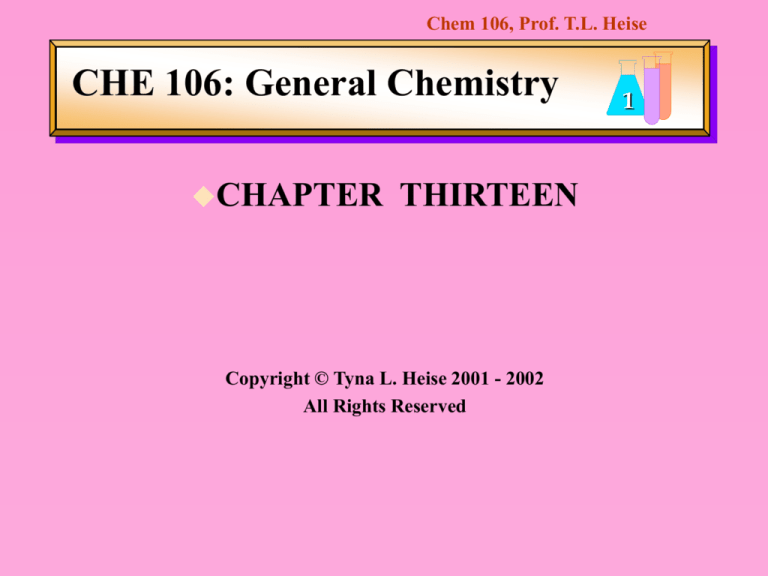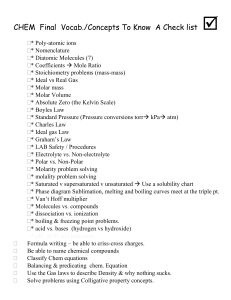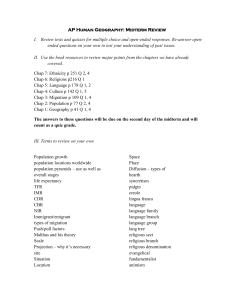
Chem 106, Prof. T.L. Heise
CHE 106: General Chemistry
CHAPTER
THIRTEEN
Copyright © Tyna L. Heise 2001 - 2002
All Rights Reserved
1
Chem 106, Prof. T.L. Heise
The Solution Process
2
• Solution - homogeneous mixture of two
or more substances
• Solvent - substance of greater amount in
the homogeneous mixture (solution)
• Solute - compounds “dissolved” in the
solvent
• Concentration - the amount of solute
dissolved in a solvent. Expressed in
molarity (M)
Chap 13.1
Chem 106, Prof. T.L. Heise
The Solution Process
3
• Solution -may be gases, liquids or solids
– Examples:
air
ocean water
10K gold (alloy)
Chap 13.1
Chem 106, Prof. T.L. Heise
The Solution Process
4
A solution is formed when one substance disperses
uniformly through another.
All solutions, except gas mixtures, involve substances
in a condensed state
Intermolecular forces are also going to operate
between solute and solvent
- interactions are known as solvation
- when solvent is water, the interactions are
known as hydration
Chap 13.1
Chem 106, Prof. T.L. Heise
The Solution Process
5
Chap 13.1
Chem 106, Prof. T.L. Heise
The Solution Process
6
Energy changes during solution formation is the sum
of three energy changes:
DH1 = separation of solute molecules
DH2 = separation of solvent molecules
DH3 = formation of solute-solvent
interactions
DH1 and DH2 are endothermic because you are
breaking or overcoming interactive forces
DH3 is exothermic due to the creation of new
forces
Chap 13.1
Chem 106, Prof. T.L. Heise
The Solution Process
7
Chap 13.1
Chem 106, Prof. T.L. Heise
The Solution Process
8
Solution Formation depends on two factors
1) energy or enthalpy changes DH
2) chaos or entropy changes DS
Natural phenomenon's occur to satisfy two basic
laws
- energy content decreases
- disorder content increases
** Formation of solutions is favored by the increase
in disorder that accompanies mixing
Chap 13.1
Chem 106, Prof. T.L. Heise
The Solution Process
9
Solution Formation can occur during two basic
processes
1) physical changes
2) chemical changes
Our focus is on physical changes, key to recognizing
difference is examining whether you can get the
salt BACK unchanged when reaction is done.
Chap 13.1
Chem 106, Prof. T.L. Heise
Saturated Solutions and Solubility10
As a solid solute is dissolved, the concentration of
dissolved particles increases, as does the chance of
a collision between to dissolved particles. If two
dissolved particles collide, the attractive forces
could cause recrystallization
In any solution
Solute + solvent dissolve
solution
crystallize
Chap 13.2
Chem 106, Prof. T.L. Heise
Saturated Solutions and Solubility11
Saturated: in equilibrium, rate of dissolving equals
rate of crystallization, concentration
remains constant
Solubility: the amount of solute needed to form a
saturated solution in a given
temperature
Unsaturated: dissolved less the amount needed to
form a saturated solution
Supersaturated: dissolving more than the amount
Chap 13.2
needed
Chem 106, Prof. T.L. Heise
Saturated Solutions and Solubility12
Chap 13.2
Chem 106, Prof. T.L. Heise
Factors Affecting Solubility
13
• Solute-Solvent Interactions
» the stronger the the attractions between
solute and solvent, the greater the solubility
» miscible and immiscible
» like dissolves like
Chap 13.3
Chem 106, Prof. T.L. Heise
Factors Affecting Solubility
14
• Pressure Effects
» the solubility of a gas in any solvent is
increased as the pressure of the gas over the
solvent is increased
Chap 13.3
Chem 106, Prof. T.L. Heise
Factors Affecting Solubility
15
• Pressure Effects
» relationship between pressure and the
solubility of a gas is expressed in terms of a
simple equations known as Henry’s Law
Chap 13.3
Chem 106, Prof. T.L. Heise
Factors Affecting Solubility
16
Sample Exercise: Calculate the concentration
of CO2 in a soft drink after the bottle is
opened and equilibrates at 25°C under a CO2
partial pressure of 3.0 x 10-4 atm.
Chap 13.3
Chem 106, Prof. T.L. Heise
Factors Affecting Solubility
17
Sample Exercise: Calculate the concentration
of CO2 in a soft drink after the bottle is
opened and equilibrates at 25°C under a CO2
partial pressure of 3.0 x 10-4 atm.
1) Cg = kPg
Chap 13.3
Chem 106, Prof. T.L. Heise
Factors Affecting Solubility
18
Sample Exercise: Calculate the concentration
of CO2 in a soft drink after the bottle is
opened and equilibrates at 25°C under a CO2
partial pressure of 3.0 x 10-4 atm.
1) Cg = kPg
Cg = x
k = 3.1 x 10-2 mol/L-atm(given page 480)
Pg = 3.0 x 10-4 atm
Chap 13.3
Chem 106, Prof. T.L. Heise
Factors Affecting Solubility
19
Sample Exercise: Calculate the concentration
of CO2 in a soft drink after the bottle is
opened and equilibrates at 25°C under a CO2
partial pressure of 3.0 x 10-4 atm.
1) Cg = kPg
x = 3.1 x 10-2 mol/L-atm(3.0 x 10-4 atm)
Chap 13.3
Chem 106, Prof. T.L. Heise
Factors Affecting Solubility
20
Sample Exercise: Calculate the concentration
of CO2 in a soft drink after the bottle is
opened and equilibrates at 25°C under a CO2
partial pressure of 3.0 x 10-4 atm.
1) Cg = kPg
x = 3.1 x 10-2 mol/L-atm(3.0 x 10-4 atm)
x = 9.3 x 10-6 mol/L
Chap 13.3
Chem 106, Prof. T.L. Heise
Factors Affecting Solubility
21
• Temperature Effects
» solubility of most solid solutes increases as
the temperature of the solution does
» solubility of most gases decreases as
temperature of the solution does
» look up solubility on a solubility table to
find exact trend
Chap 13.3
Chem 106, Prof. T.L. Heise
Factors Affecting Solubility
• Temperature Effects
22
Chap 13.3
Chem 106, Prof. T.L. Heise
Expressing Concentration
23
• Dilute - relatively small concentration of
solute in solution
• Concentrated - relatively large concentration
of solute in solution
• Ways to express numerically•mass percentage
•mole fraction
•molarity
•molality
Chap 13.4
Chem 106, Prof. T.L. Heise
Expressing Concentration
24
• mass percentage
mass of component *100
total mass of soln
• ppm
mass of component *100,000
total mass of soln
• ppb
mass of component *100,000,000
total mass of soln
Chap 13.4
Chem 106, Prof. T.L. Heise
Expressing Concentration
25
Sample Exercise: Calculate the mass
percentage of NaCl in a solution containing
1.50 g of NaCl in 50.0 g of water
Chap 13.4
Chem 106, Prof. T.L. Heise
Expressing Concentration
26
Sample Exercise: Calculate the mass
percentage of NaCl in a solution containing
1.50 g of NaCl in 50.0 g of water
mass percent = mass of component * 100
total mass of soln
Chap 13.4
Chem 106, Prof. T.L. Heise
Expressing Concentration
27
Sample Exercise: Calculate the mass
percentage of NaCl in a solution containing
1.50 g of NaCl in 50.0 g of water
mass percent = mass of component * 100
total mass of soln
= 1.50 g NaCl *100
51.50 g soln
Chap 13.4
Chem 106, Prof. T.L. Heise
Expressing Concentration
28
Sample Exercise: Calculate the mass
percentage of NaCl in a solution containing
1.50 g of NaCl in 50.0 g of water
mass percent = mass of component * 100
total mass of soln
= 1.50 g NaCl *100
51.50 g soln
=2.91 %
Chap 13.4
Chem 106, Prof. T.L. Heise
Expressing Concentration
29
Sample Exercise: a commercial bleaching
solution contains 3.62 mass percent sodium
hypochlorite, NaOCl. What is the mass of
NaOCl in a bottle containing 2500 g of
bleaching solution?
Chap 13.4
Chem 106, Prof. T.L. Heise
Expressing Concentration
30
Sample Exercise: a commercial bleaching
solution contains 3.62 mass percent sodium
hypochlorite, NaOCl. What is the mass of
NaOCl in a bottle containing 2500 g of
bleaching solution?
mass percent = mass of component * 100
total mass of soln
Chap 13.4
Chem 106, Prof. T.L. Heise
Expressing Concentration
31
Sample Exercise: a commercial bleaching
solution contains 3.62 mass percent sodium
hypochlorite, NaOCl. What is the mass of
NaOCl in a bottle containing 2500 g of
bleaching solution?
mass percent = mass of component * 100
total mass of soln
3.62 % =
x
* 100
2500 g soln
3.62 % * 2500g = x
Chap 13.4
100%
Chem 106, Prof. T.L. Heise
Expressing Concentration
32
Sample Exercise: a commercial bleaching
solution contains 3.62 mass percent sodium
hypochlorite, NaOCl. What is the mass of
NaOCl in a bottle containing 2500 g of
bleaching solution?
mass percent = mass of component * 100
total mass of soln
3.62 % =
x
* 100
2500 g soln
3.62 % * 2500g = x
Chap 13.4
100%
90.5 g NaOCl
Chem 106, Prof. T.L. Heise
Expressing Concentration
33
• mole fraction
mole fraction = moles of component
total moles of all components
• symbol X is often used to represent mole
fraction
• molarity = moles of solute/L of solution
molality = moles of solute/kg of solvent
Chap 13.4
Chem 106, Prof. T.L. Heise
Expressing Concentration
34
Sample Exercise: What is the molality of a
solution made by dissolving 36.5 g
naphthalene, C10H8, in 428 g of toluene,
C7H8?
Chap 13.4
Chem 106, Prof. T.L. Heise
Expressing Concentration
35
Sample Exercise: What is the molality of a
solution made by dissolving 36.5 g
naphthalene, C10H8, in 428 g of toluene,
C7H8?
1) molality = moles of solute
kg of solvent
Chap 13.4
Chem 106, Prof. T.L. Heise
Expressing Concentration
36
Sample Exercise: What is the molality of a
solution made by dissolving 36.5 g
naphthalene, C10H8, in 428 g of toluene,
C7H8?
1) molality = moles of solute
kg of solvent
moles = 36.5 g C10H8
1 mol
= 0.285 mol
128 g C10H8
Chap 13.4
Chem 106, Prof. T.L. Heise
Expressing Concentration
37
Sample Exercise: What is the molality of a
solution made by dissolving 36.5 g
naphthalene, C10H8, in 428 g of toluene,
C7H8?
1) molality = moles of solute
kg of solvent
moles = 0.285 mol
kg = 428g
1 kg = 0.428 kg
1000 g
Chap 13.4
Chem 106, Prof. T.L. Heise
Expressing Concentration
38
Sample Exercise: What is the molality of a
solution made by dissolving 36.5 g
naphthalene, C10H8, in 428 g of toluene,
C7H8?
1) molality = moles of solute
kg of solvent
moles = 0.285 mol
= 0.285 mol
kg = 0.428 kg
0.428 kg
Chap 13.4
= 0.670 mol/kg
Chem 106, Prof. T.L. Heise
Expressing Concentration
39
Sample Exercise: A commercial bleach
solution contains 3.62 mass percent NaOCl
in water. Calculate (a) the molality
(b) the mole fraction of
NaOCl
Chap 13.4
Chem 106, Prof. T.L. Heise
Expressing Concentration
40
Sample Exercise: A commercial bleach
solution contains 3.62 mass percent NaOCl
in water. Calculate (a) the molality
mass % = mass of solute *100
mass of solution
Chap 13.4
Chem 106, Prof. T.L. Heise
Expressing Concentration
41
Sample Exercise: A commercial bleach
solution contains 3.62 mass percent NaOCl
in water. Calculate (a) the molality
mass % = mass of solute *100
mass of solution
3.62% = mass of solute * 100
100 g solution
Chap 13.4
* when not
given an amount
f solution, assume 100g.
Chem 106, Prof. T.L. Heise
Expressing Concentration
42
Sample Exercise: A commercial bleach
solution contains 3.62 mass percent NaOCl
in water. Calculate (a) the molality
mass of solute = 3.62 g
molality = moles
kg
3.62 g NaOCl
1 mol NaOCl
= 0.0486 mol
74.44 g NaOCl
Chap 13.4
Chem 106, Prof. T.L. Heise
Expressing Concentration
43
Sample Exercise: A commercial bleach
solution contains 3.62 mass percent NaOCl
in water. Calculate (a) the molality
molality = moles = 0.0486 mol = 0.505 mol
kg
0.09638 kg
kg
Chap 13.4
*don’t forget we assumed 100 g of
solution, so 3.62 g of NaOCl and
96.28 g water
Chem 106, Prof. T.L. Heise
Expressing Concentration
44
Sample Exercise: A commercial bleach
solution contains 3.62 mass percent NaOCl
in water. Calculate (b) mole fraction of
NaOCl
Mole fraction = moles of solute
total moles of components
Chap 13.4
Chem 106, Prof. T.L. Heise
Expressing Concentration
45
Sample Exercise: A commercial bleach
solution contains 3.62 mass percent NaOCl
in water. Calculate (b) mole fraction of
NaOCl
Mole fraction = moles of solute
total moles of components
3.62 g NaOCl
1 mol NaOCl = 0.0486 mol
74.44 g NaOCl
NaOCl
96.38 g H2O
1 mol H2O = 5.35 mol H2O
18 g H2O
Chap 13.4
Chem 106, Prof. T.L. Heise
Expressing Concentration
46
Sample Exercise: A commercial bleach
solution contains 3.62 mass percent NaOCl
in water. Calculate (b) mole fraction of
NaOCl
Mole fraction = moles of solute
total moles of components
0.0486 mol NaOCl
= 0.00900
0.0486 mol NaOCl + 5.35 mol H2O
Chap 13.4
Chem 106, Prof. T.L. Heise
Colligative Properties
47
Certain physical properties of solutions differ
from the pure solvent
- lowering freezing point
- raising boiling point
- reduction of vapor pressure
- alteration of osmotic pressure
Chap 13.5
Chem 106, Prof. T.L. Heise
Colligative Properties
Vapor Pressure
48
Vapor
pressure is
the pressure
exerted by
the vapor on
the surface
when closed
flask
achieves
equilibrium
Chap 13.5
Chem 106, Prof. T.L. Heise
Colligative Properties
49
Boiling Point
Kb is the molal boiling point constant and is
equal to 0.52°C/m
- this constant is related to the number of
dissolved particles
Chap 13.5
Chem 106, Prof. T.L. Heise
Colligative Properties
50
Freezing Point
Kf is the molal boiling point constant and is
equal to 1.87°C/m
- this constant is related to the number of
dissolved particles
Chap 13.5
Chem 106, Prof. T.L. Heise
Expressing Concentration
51
Sample Exercise: Calculate the freezing point
of a solution containing 0.600 kg of CHCl3
and 42.0 g of eucalyptol, C10H18O, a fragrant
substance found in the leaves of the
eucalyptus tree.
Chap 13.5
Chem 106, Prof. T.L. Heise
Expressing Concentration
52
Sample Exercise: Calculate the freezing point
of a solution containing 0.600 kg of CHCl3
and 42.0 g of eucalyptol, C10H18O, a fragrant
substance found in the leaves of the
eucalyptus tree.
molality = moles of solute
kg of solvent
Chap 13.5
Chem 106, Prof. T.L. Heise
Expressing Concentration
53
Sample Exercise: Calculate the freezing point
of a solution containing 0.600 kg of CHCl3
and 42.0 g of eucalyptol, C10H18O, a fragrant
substance found in the leaves of the
eucalyptus tree.
molality = moles of solute
kg of solvent
42.0 g C10H18O 1 mol C10H18O = 0.273 mol
154 g C10H18O
Chap 13.5
Chem 106, Prof. T.L. Heise
Expressing Concentration
54
Sample Exercise: Calculate the freezing point
of a solution containing 0.600 kg of CHCl3
and 42.0 g of eucalyptol, C10H18O, a fragrant
substance found in the leaves of the
eucalyptus tree.
molality = moles of solute
kg of solvent
= 0.273 mol
0.600 kg
Chap 13.5
= 0.455 m
Chem 106, Prof. T.L. Heise
Expressing Concentration
55
Sample Exercise: Calculate the freezing point
of a solution containing 0.600 kg of CHCl3
and 42.0 g of eucalyptol, C10H18O, a fragrant
substance found in the leaves of the
eucalyptus tree.
DTf = Kfm
= 4.68(0.455)
= 2.13°C
Normal Tf = -63.5°C
-2.13°C
Chap 13.5
New Tf = -65.6°C
Chem 106, Prof. T.L. Heise
Expressing Concentration
56
Sample Exercise: Which of the following
solutes will produce the largest increase in
boiling point upon addition of 1 kg of water:
1 mol Co(NO3)2
2 mol KCl
3 mol C2H6O2
Chap 13.4
Chem 106, Prof. T.L. Heise
Expressing Concentration
57
Sample Exercise: Which of the following
solutes will produce the largest increase in
boiling point upon addition of 1 kg of water:
1 mol Co(NO3)2
DTf = Kfm
= 1.87(1)
= 1.87°C
Chap 13.4
Chem 106, Prof. T.L. Heise
Expressing Concentration
58
Sample Exercise: Which of the following
solutes will produce the largest increase in
boiling point upon addition of 1 kg of water:
2 mol KCl
DTf = Kfm
= 1.87(4)
= 7.48°C
Chap 13.4
Chem 106, Prof. T.L. Heise
Expressing Concentration
59
Sample Exercise: Which of the following
solutes will produce the largest increase in
boiling point upon addition of 1 kg of water:
3 mol C2H6O2
DTf = Kfm
= 1.87(3)
= 5.61°C
Chap 13.4
Chem 106, Prof. T.L. Heise
Expressing Concentration
60
Sample Exercise: Which of the following
solutes will produce the largest increase in
boiling point upon addition of 1 kg of water:
1 mol Co(NO3)2 = -1.87 °C
2 mol KCl
= -7.48 °C
3 mol C2H6O2
= -5.61 °C
Chap 13.4
Chem 106, Prof. T.L. Heise
Colligative Properties
Osmotic Pressure
61
The net movement of solvent is
always toward the solution with
the higher solute concentration.
The pressure needed to stop
such movement is called osmotic
pressure
Chap 13.5
Chem 106, Prof. T.L. Heise
Colligative Properties
62
Osmotic Pressure
Chap 13.5
Chem 106, Prof. T.L. Heise
Colloids
63
Chap 13.6








